
Glossodoris rubroannulata
Rudman, 1986
Order: NUDIBRANCHIA
Suborder: DORIDINA
Family: Chromodorididae
DISTRIBUTION
Known only from Queensland - New South Wales border region and New Caledonia.
PHOTO
Coffs Harbour region, northern New South Wales, March 1986.
Photo: Bill Rudman.
Quite similar in colour to Glossodoris cruenta which differs in having a row of red spots along the inner edge of the white rather than a thin red line along the outer edge.
Reference:
• Rudman, W.B. (1986) The Chromodorididae (Opisthobranchia: Mollusca) of the Indo-West Pacific: The genus Glossodoris Ehrenberg (= Casella, H. & A. Adams). Zoological Journal of the Linnean Society 86(2): 101-184.
Rudman, W.B., 1998 (May 26) Glossodoris rubroannulata Rudman, 1986. [In] Sea Slug Forum. Australian Museum, Sydney. Available from http://www.seaslugforum.net/find/glosrubr
Related messages
Re: Glossodoris rubroannulata from nthn New South Wales
August 31, 2007
From: Leanne & David Atkinson
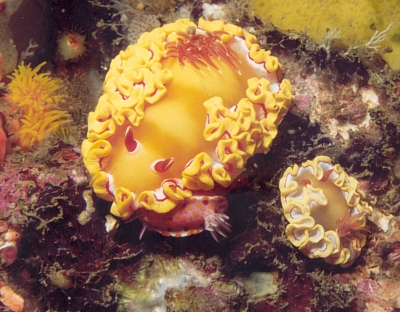
Hi Bill,
Concerning your request for a higher resolution scan of the photo in our earlier message #15384, here is a higher resolution scan of the original photo we sent you plus another one that shows the area in front of the nudibranch from a different angle and a bit better light. They were photographed at Northwest Solitary Island in Northern NSW in September 2000 in approximately 10 metres. We also saw Hypselodoris jacksoni on the same dive. We must get back there sometime soon.
Hope these help,
Leanne & David Atkinson
atk@hunterlink.net.au
Atkinson, L.& D., 2007 (Aug 31) Re: Glossodoris rubroannulata from nthn New South Wales. [Message in] Sea Slug Forum. Australian Museum, Sydney. Available from http://www.seaslugforum.net/find/20604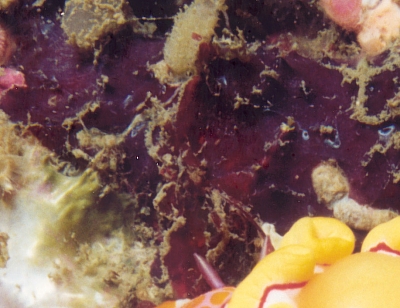
Dear Leanne & David,
Thanks for your quick reponse.As I explained in my email to you, after getting Dave Mullins' feeding photo [#20602] yesterday, I thought it would be useful to see if we could squeeze any more information out of your earlier photo, as it was the only other indication we had on what G. rubroannulata ate.
Unfortunately I still can't be sure if it is a relatively smooth colony or a sculptured and conulose colony like in Dave Mullin's photo. I had hoped the Ceratosoma amoena in the picture might have given us some useful clues because, as you suggested, it seems to be feeding as well. However C. amoena feeds on both a sculptured and conulose species of Dysidea and an unrelated, relatively smooth colony of the thorectid Semitaspongia. The only thing I can definitely say is that the colour of the sponge in your photos is quite similar to the one in Dave's, which unfortunately doesn't help that much. I guess this could be another reason to add to your list in favour of getting back up to the Solitary Islands.
Best wishes,
Bill Rudman
Glossodoris rubroannulata - more feeding pics
August 31, 2007
From: David Mullins
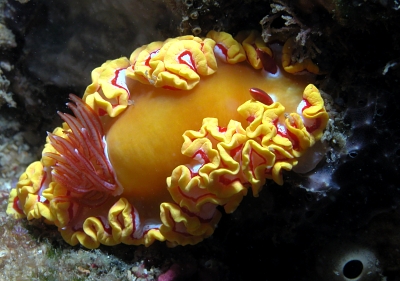
Dear Bill,
To follow my earlier message [#20602], here is a series of photos where perhaps the species is feeding on a sponge. This series is taken on the same day as the series of egg laying photos [#20606 ], but a different specimen is involved. Also as you will note both these series of photos were taken months apart from any of the photos in the very first message about this species.
Locality: Old Woman Island, Maroochydore, 12 metres, Queensland, Australia, Pacific Ocean, 3 September 2005, rocky reef. Length: 70 mm. Photographer: David Mullins.
One image [middle left] is taken from behind as it approaches its prey which may be the grey sponge partially visible to its right. The others are taken from the right side where the oral tube appears evident, spread over a grey sponge. I am ignorant of sponge identification as you are aware so I will leave this to the dabblers in the "black arts".
I once again hope I have been of assistance.
Kind regards,
David Mullins
david@nudibranch.com.au
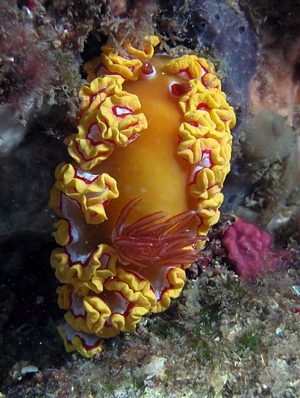
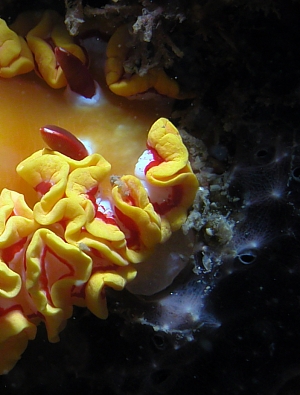
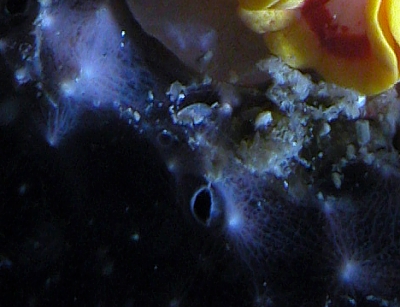
Dear David,
Just to enlighten other visitors to the Forum, when David sent me his first message yesterday On G. rubroannulata I found the observations so interesting that I immediately emailed him to see if he had any more. So thanks David, this ceratinly confirms it is eating the same sponge as in your other message. All I need to do is confirm its identity.
I must say I used to think indentifying sponges was a bit like 'dabbling in the black arts' especially when all those eaten by chromodorids lacked spicules, to use in identification. Fortunately Prof. Bergquist has been studying sponges longer than I have been studying nudibranchs - in fact she was one of my teachers at university - and luckily she specialises in just the sponges that chromodorids feed on, and has long been a leading advocate for the use of secondary metabolite chemistry in studying their phylogenetic relationships.
Best wishes,
Bill Rudman
Glossodoris rubroannulata - more pics spawning?
August 31, 2007
From: David Mullins
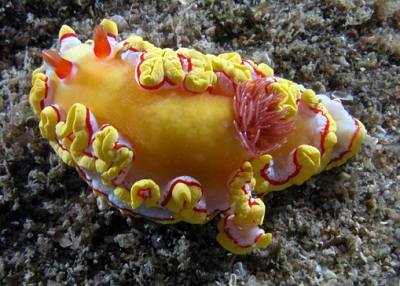
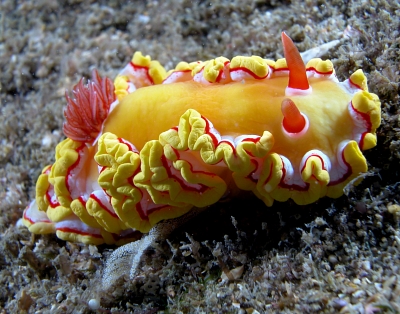
Dear Bill,
Hopefully to shed more light on the egg ribbon of this species I have forwarded a series of photos taken at a different time [see message #20602 ].
Locality: Old Woman Island, Maroochydore, 12 metres, Queensland, Australia, Pacific Ocean, 3 September 2005, rocky reef. Length: 80 mm. Photographer: David Mullins.
In the upper image the specimen is observed to be injured on the left hand side. In the past I have noticed that often when nudibranchs are stressed, one of the first things some do is lay eggs. In the other image I have swapped to the other side and there is a short trail of eggs appearing from its right side and on looking carefully they disappear under the mantle but they are not below the foot, so I deduce the ribbon is emanating from the genital pore. I believe it seems to be quite similar to the egg ribbon in the previous message.
I would not usually release these images publicly because I am not entirely happy with the quality. However as a "gentleman scientist" (a la Sir Joseph Banks) I am only too willing to help.
KInd regards,
David Mullins.
david@nudibranch.com.au
Mullins, D.A., 2007 (Aug 31) Glossodoris rubroannulata - more pics spawning?. [Message in] Sea Slug Forum. Australian Museum, Sydney. Available from http://www.seaslugforum.net/find/20606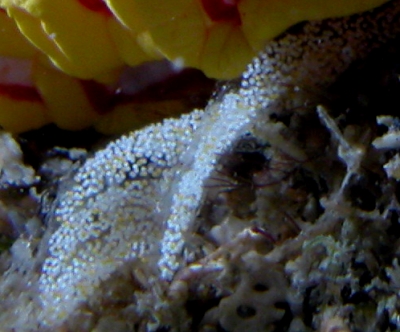
Dear David,
Thanks again. I know photographers only like to show their best photos, but I can't see anything wrong with these photos as photos and they are a valuable additon to our knowledge of this species. Long live the tradition of the gentleman [and gentlewoman] scientist!
I think two observations of G. rubroannulata with this type of egg-ribbon is a pretty good indication that these are the type of eggs it lays.
Best wishes,
Bill Rudman
Glossodoris rubroannulata - natural history [2]
August 31, 2007
From: David Mullins
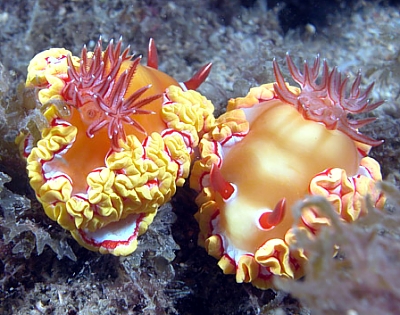
Concerning message #20602:
Dear Bill,
To acompany my earlier message on behavioural records of Glossodoris rubroannulata, here is a photo of a pair mating.
Locality: Old Woman Island, Maroochydore, Queensland, Australia, Pacific Ocean. Depth: 12 metres. Length: 80 mm. 30 September 2006. Photographer: David Mullins
Kind regards,
David Mullins.
david@nudibranch.com.au
Mullins, D. A., 2007 (Aug 31) Glossodoris rubroannulata - natural history [2]. [Message in] Sea Slug Forum. Australian Museum, Sydney. Available from http://www.seaslugforum.net/find/20610Thanks David,
Bill Rudman
Rudman, W.B., 2007 (Aug 31). Comment on Glossodoris rubroannulata - natural history [2] by David Mullins. [Message in] Sea Slug Forum. Australian Museum, Sydney. Available from http://www.seaslugforum.net/find/20610Glossodoris rubroannulata - natural history [1]
August 31, 2007
From: David Mullins
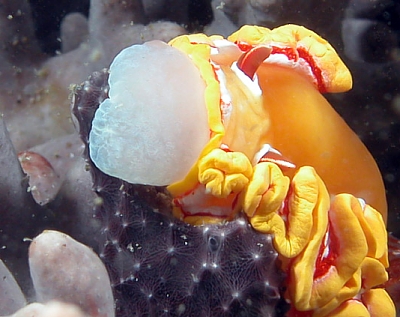
Dear Bill,
I thought the forum might appreciate some behavioural records of Glossodoris rubroannulata Rudman, 1986.
This beautiful species,always a joy to photograph,is regularly sighted here on the Sunshine Coast. I have many gorgeous portraits of this nudibranch but no doubt the readers are more interested in those that add to our resource of knowledge. The photos demonstrate feeding and spawning. The spawn seems to exhibit the extra-capsular yolk that you have mentioned previously with other species. This specimen was located beneath a dead coral head.
Locality: Upper photo: [showing feeding] "Trench", Mooloolaba, 18 metres, Queensland, Australia, Pacific Ocean, 14 January 2006, Rocky Reef. Length: 75 mm. Lower photo: [showing egg-laying] "Wait-a-while", Gneering Shoals, Mooloolaba, Queensland, Australia, Pacific Ocean. Depth: 14 metres. Length: 80 mm. 14 June 2004. Photographer: David Mullins.
Kind regards,
David Mullins.
david@nudibranch.com.au
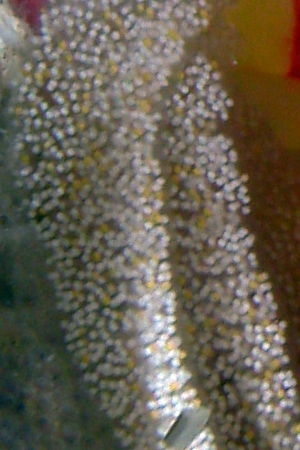
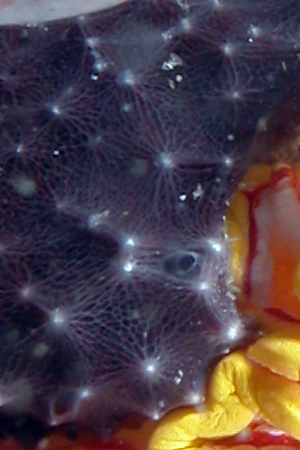
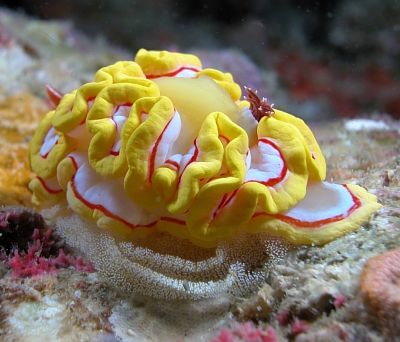
Dear David,
I sometimes think I sound like a squeaky wheel always asking for photos of these animals 'doing things' but your message perfectly illustrates the value of learning more about their biology and natural history. Althought it is vital to know their anatomical details, and I have spent my career looking at anatomical details, sometimes there just don't seem to be sufficient differences to be sure just what is going on. So looking at things like egg ribbons and feeding behaviour can give us another suite of characters to consider.
As Nerida Wilson has shown [#8611], chromodorids which lay a flat egg ribbon are almost certainly a separate phylogenetic group to other species of Chromodoris that don't. And my recent feeding review [#20272] shows that these flat-egg producing chromodorids also feed on different sponges as well.
Which brings me to your animals. Glossodoris is another genus with some puzzling anatomical subgroups, and G. rubroannulata belongs to one subgroup with similarities to 'Chromodoris'. Your discovery of this egg ribbon with extra-capsular yolk is interesting, because up until now species of Chromodoris, but not species of Glossodoris, have been reported to have this type of egg ribbon [see Fact Sheet]. The other interesting thing is the sponge your animal is eating. Species of Glossodoris seem to feed exclusively on thorectid sponges, and this is not a thorectid. I am pretty sure I know what it is but I am sending it off to Pat Bergquist for a definitive identification. It seems from your observations that we will need to seriously consider whether G. rubroannulata is indded a Glossodoris.
Thanks again for these interesting finds
Best wishes,
Bill Rudman
Glossodoris rubroannulata from Jervis Bay
March 29, 2006
From: Sue Newson
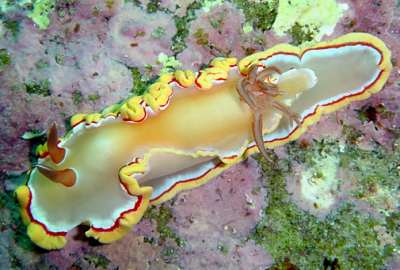
Hi Bill,
I recently found this beauty in Jervis Bay. Further south than previous messages indicate. I personally have never seen Glossodoris rubroannulata in Jervis Bay before. However, there does seem to be more tropical fish sighted this summer than in previous years. I found it interesting that this one also has the white foot, as in other messages in NSW waters.
Locality: The Nursery, Bowen Island, 8 meters, NSW, Australia, Jervis Bay, 25 March 2006, "bare" boulders on rocky reef. Length: approx 10cm. Photographer: Sue Newson.
Cheers,
Sue
suenewson@optusnet.com.au
Newson, S., 2006 (Mar 29) Glossodoris rubroannulata from Jervis Bay. [Message in] Sea Slug Forum. Australian Museum, Sydney. Available from http://www.seaslugforum.net/find/16193Dear Sue,
It certainly seems to be a year for tropical animals to venture south. I note something has taken a nibble around the edge of the posterior part of its mantle skirt. See the opaque white band around the inside of the red line. That is the inner edge of a band of glands which lie under the yellow border all around the edge of the mantle and store distasteful chemicals from its sponge food. They are part of the nudibranchs defence system and although its a bit damaged the chemicals apparently protected the slug from being eaten.
Best wishes,
Bill Rudman
Glossodoris rubroannulata from nthn New South Wales
November 30, 2005
From: L. & D. Atkinson
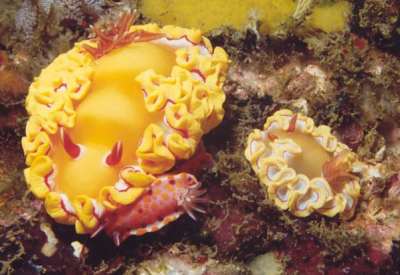
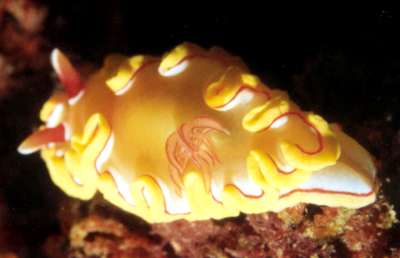
Dear Bill,
After reading Rachel Murphy's message [#15353] about Glossodoris rubroannulata and your reply about their sightings being rare we thought you might like to add these photos from the Solitary Islands in Northern NSW.
Locality: No Name Mooring, North West Solitary Island, Northen NSW, Australia. Depth: 5 metres. Length: 6 cm to 12 cm roughly. 13th September 2000. Coral Reef with sponges and algae. Photographer: Leanne & David Atkinson
There were three Glossodoris rubroannulata under an over hang in a shallow surgey piece of reef. They were difficult to photograph because of the upward angle and the surge. We weren't sure whether the largest one was competing with the Ceratosoma amoena for food or whether it was just a case of I'm crawling this way regardless of what's in my way. The Ceratosoma amoena was a regular size for that species so this photo gives a good size comparison. The rear shot shows a white tail edged with yellow and an inner red line. Your fact page sample photo appears to have a yellow tail. Have we made the right identification?
Regards,
Leanne & David Atkinson
atk@hunterlink.net.au
Atkinson, L. & D., 2005 (Nov 30) Glossodoris rubroannulata from nthn New South Wales. [Message in] Sea Slug Forum. Australian Museum, Sydney. Available from http://www.seaslugforum.net/find/15384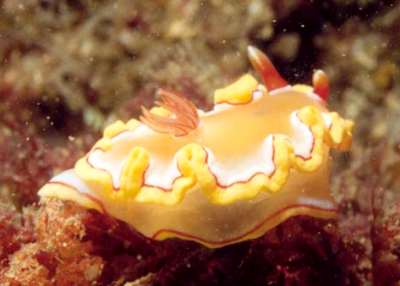
Dear Leanne & David,
Records are always welcome. It seems that the white oigmentation on the foot and sides of the body of this species can vary somewhat. If you look at David Power's animal from Sydney [message #13831] it appears to have the whole of the sides of the body/foot white rather than just a submarginal band at the edge. Your suggestion that the Ceratosoma amoena and the Glossodoris might be feeding on the same sponge, could well be so.
Best wishes,
Bill Rudman
Glossodoris rubroannulata from southern Queensland
November 25, 2005
From: Rachel Murphy
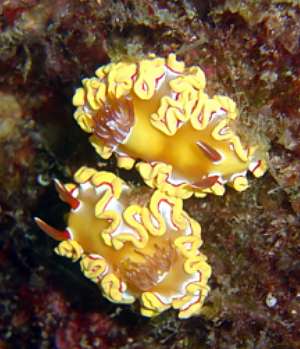
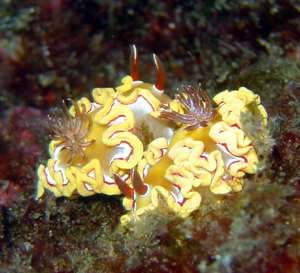
Hi Bill
These two Glossodoris rubroannulata, while head to tail, weren't actually doing the deed. Hung around the area for about 7min (which seemed interminable) but nothing more than sidling next to each other. They were on the underside of a boulder which made for difficult viewing and photography in the surge. It was about 4.30pm and the sea temp 23C.
Locality: Flinders Reef, Brisbane, QLD, Australia. Depth: 9 m. 19 November 2005. Coral Reef. Photographer: Rachel Murphy
Regards
Rachel
rmurphy@cicr.uq.edu.au
Murphy, R.M., 2005 (Nov 25) Glossodoris rubroannulata from southern Queensland. [Message in] Sea Slug Forum. Australian Museum, Sydney. Available from http://www.seaslugforum.net/find/15353Thanks Rachel,
This is quite a rarity, so any records are valuable
Best wishes,
Bill Rudman
Glossodoris rubroannulata in Sydney?
May 20, 2005
From: David Power
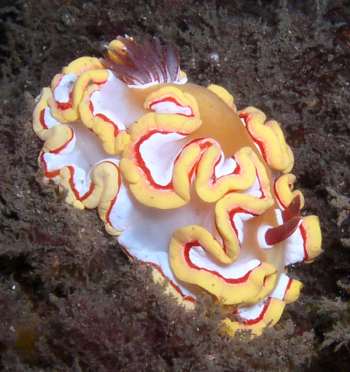
Hi Bill
I saw this whilst diving near the heads just inside Sydney Harbour. I was wondering if you could confirm if this is in fact Glossodoris rubroannulata.
On the species list it is cited as being found in warmer tropical waters. Is it commonly sited in Sydney?
I do hope so as it made my dive to see such a beautiful creature.
Locality: Sydney Harbour, NSW. Australia. Pacific ocean. Depth: 6 m. 15 May 2005 Sheltered rocky reef. Photographer: David Power
Thanks very much for your help
Regards,
David
davidpower_@hotmail.com
Power, S. D., 2005 (May 20) Glossodoris rubroannulata in Sydney?. [Message in] Sea Slug Forum. Australian Museum, Sydney. Available from http://www.seaslugforum.net/find/13831Dear David,
This is indeed Glossodoris rubroannulata which is certainly a rare find even in tropical waters. It is certainly unusual to find it as far south as Sydney. However you can expect to find a wide variety of more tropical animals anywhere along the New South wales coast, as their larvae can be swept down in the warm water currents and eddies that move south down the east Australian coast.
Your animal seems to be a bit unusual in the amount of white pigmentation it has. The white band on the mantle is much wider than normal, and the side of the body is usually translucent yellow with white, red and yellow bands at the edge of the foot. In your animal the whole of the side of the body/foot is white, except for the red and yellow border.
Best wishes,
Bill Rudman
Glossodoris rubroannulata from Sydney
September 30, 2002
From: Akos Lumnitzer
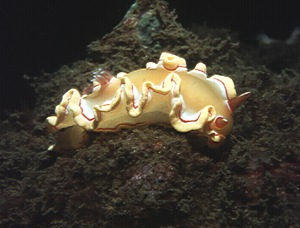
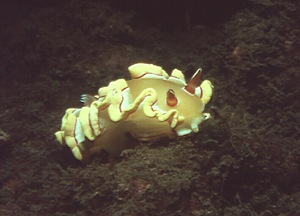
Hi Bill,
Here are some shots of Glossodoris rubroannulata at La Perouse, Sydney, [NSW, Australia] in 12m of water [March 2002].
Kind regards
Akos
dna72@softhome.net
Lumnitzer, A., 2002 (Sep 30) Glossodoris rubroannulata from Sydney. [Message in] Sea Slug Forum. Australian Museum, Sydney. Available from http://www.seaslugforum.net/find/7609Thanks Akos,
It's interesting to get records of this species so far south.
Best wishes,
Bill Rudman
Found at Mooloolaba
May 26, 1998
From: Wayne Ellis
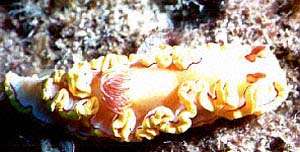
Bill,
Here is one of Steve Grail's photos for identification. He basically told me the pics were taken 10-20m, between 1996-98 off Mooloolaba.
Regards,
Wayne Ellis
glaskin@ozemail.com.au
Ellis, W., 1998 (May 26) Found at Mooloolaba. [Message in] Sea Slug Forum. Australian Museum, Sydney. Available from http://www.seaslugforum.net/find/64This is Glossodoris rubroannulata which is at present only known from southern Queensland, northern New South Wales and New Caledonia. There are a group of molluscs which seem to have this restricted Coral Sea distribution.
Rudman, W.B., 1998 (May 26). Comment on Found at Mooloolaba by Wayne Ellis. [Message in] Sea Slug Forum. Australian Museum, Sydney. Available from http://www.seaslugforum.net/find/64